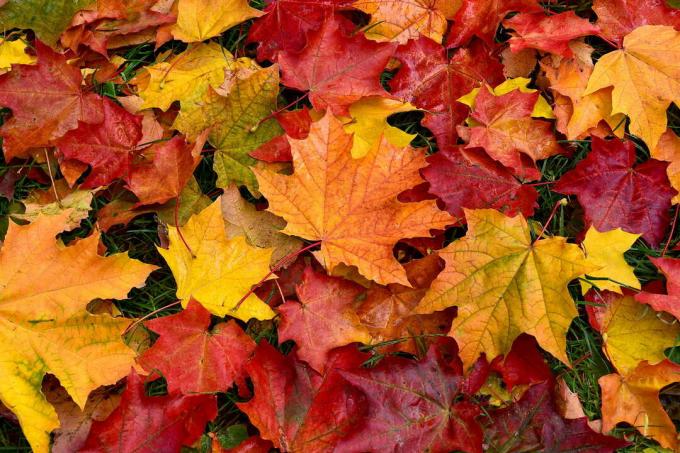Fall leaves are plentiful, so why not use them? We'll show you what you can do with leaves.

Autumn is here and the trees are colourful. But the play of colors does not inspire everyone, after all, the falling leaves also mean a lot of work. For all those who value a well-tended garden, this is the time to rake the leaves. But what to do with all the leaves that you find in your home garden? We'll show you five ways you can do something good for your garden with autumn leaves.
contents
- Fall Foliage Tip 1: Mulch
- Fall foliage tip 2: Natural frost protection
- Fall foliage tip 3: Beds made of leaves
- Autumn Leaves Tip 4: From Leaves to Compost
- Fall foliage tip 5: Hedgehog hiding spots made easy
Leaves are plentiful and free – if you want to use your leaves instead of just throwing them away, try one of the five options below.
Fall Foliage Tip 1: Mulch
Mulching is a great way to save labor in the garden. Above all, the unloved weed plucking is a thing of the past with a good mulch layer - unwanted weeds are simply suppressed by the layer and thus no longer have a chance. But thanks to a layer of mulch, you don't have to water as often because the moisture is better retained in the soil. The soil also benefits from the mulch layer: this supports soil life and reduces erosion of the humus layer. But instead of buying extra bark mulch or wood chips, you can simply use the autumn leaves you already have. This rots very slowly (does not need to be constantly renewed) and also enriches the soil with nutrients.

Fall foliage tip 2: Natural frost protection
Many plants don't do well with the cold temperatures and wet weather of winter. But with a bit of autumn leaves you can protect plants in the bed from the bad winter weather. To do this, the leaves are distributed generously in the bed like a layer of mulch and piled up a little on the stem. Due to the many small air spaces between the leaves, the foliage layer acts as a natural insulation and thus protects the plant from frost and frostbite. Rain is also kept out by the layer of leaves: like a roof with shingles, the water flows in from the inside outside and only seeps into the ground at the edge of the layer of leaves, so that the plant also protects itself from too much moisture will. But not only plants in the bed but also potted plants can benefit from foliage - instead of the tubs with Styrofoam or To make bubble wrap frost-proof, you can also fill a burlap sack with dry leaves and the pot of the plant put in. Here, too, the foliage acts as a natural insulator and ensures that the earth does not freeze through.

Fall foliage tip 3: Beds made of leaves
How do you create a new bed? Most would probably just dig up a patch of grass, but did you know there's a much gentler way? In fact, you can easily create a new bed with a little patience and autumn leaves. To do this, the piece of meadow that you want to convert is simply mulched with a thick layer of leaves: the one below Lawn suffocates, rots and forms a fertile garden soil, without digging and the associated soil erosion. Of course, autumn is the best time to create beds in this way: Not only are there enough leaves then, but the soil also has time to mature until spring and is ideal for the first sowing prepared.
Autumn Leaves Tip 4: From Leaves to Compost
Compost is an easy and environmentally friendly way to improve soil structure or add essential minerals to the soil. At the same time you can It is also very easy (and above all inexpensive) to make compost yourself from leaves. How exactly you compost depends mostly on taste, but also on the amount of leaves to be composted. The compost bin is more suitable for smaller amounts, while larger amounts can be placed on a compost heap. To speed up composting, it is advisable to shred the leaves (e.g. with a lawnmower) or add a composting agent. Sufficient ventilation is also important so that the microorganisms can work. However, not all leaves are necessarily suitable for composting: especially leaves of ginkgo, oak, Horse chestnut, walnut and poplar are difficult to compost and should therefore always be mixed with other leaves be mixed.

Fall foliage tip 5: Hedgehog hiding spots made easy
Hedgehogs aren't just really cute, they're also very useful: in the garden, they love to eat snails and other insects that usually like to go to our vegetable beds. A hedgehog in the garden is a real little helper and welcome. Unfortunately, many hedgehogs cannot find any sleeping quarters, since there are hardly any "wild corners" in most gardens that offer them shelter. But the prickly animals feel right at home in a pile of leaves and also have the perfect hiding place for their hibernation. So if you have a quiet, secluded corner in your garden, don't be afraid to leave some leaves - the hedgehogs will thank you. More options support hedgehogs in autumn can be found in our special article.

You ask yourself the question”Why do the leaves change color in autumn?“? We answer this question and also explain why the leaves fall in autumn.
You can find creative ideas on the topic of sustainable gardening every day on our Instagram channel. We give you tips and tricks and inform you about the latest in our Plantura products.
planturagarden
For more sustainable plant splendor 🌿
Our products come to you with ❤️ 🏠
Share your plants 📸 under #PlanturaPlants










